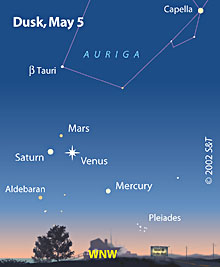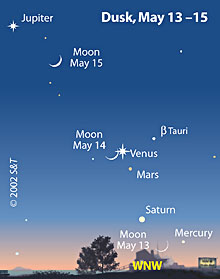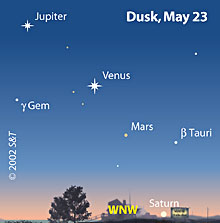 |
Home |
File a UFO Report |
View UFO Reports |
|
![]()
Planet Alignment: What is It
MAY 2002
SOURCE: Cranbook Institute of Science
A planet alignment occurs by coincidence when the moving planets of our solar system appear to gather in the sky. Often the sun and moon is included in the alignment.
If the event is viewed from deep space, far above the plane of the solar system, the sun and planets appear to be roughly lined up, hence the term "alignment."
What is the most important thing I need to know?
A planet alignment is not something that occurs suddenly during a single night, like a meteor shower. It happens over several weeks as the planets slowly move along their orbits against the backdrop of the sky. So, it is far more important to take advantage of clear weather. Get outside and see the planets whenever there is a clear night, rather than plan to observe only on certain key dates and risk getting clouded out.
When was the last alignment?
No two planet alignments are exactly the same, but an even closer grouping of the five naked-eye planets (spanning 26 degrees) occurred recently in May, 2000, but was difficult to observe because of its close proximity to the sun. This year's alignment, while not as compact, is far easier to observe.
When will the next alignment occur?
A future close gathering (spanning 9 degrees) of the five "classical" planets will be visible after sunset during the weeks centered on September 8, 2040. Also, similar groupings of the five planets occur before sunrise in July, 2060 (spanning 23 degrees) and November, 2100 (spanning 17 degrees).
The Planetary Gathering Peaks
MAY 2002
SOURCE: Sky and Telescope Online Mag
The Planetary Gathering Peaks
 |
 |
 |
May 3–7:
Five planets shine in the western sky during evening twilight. Start with bright Jupiter high up; you can't miss it. The rest are bunched together down to Jupiter's lower right. By far the most brilliant of these is Venus. Forming a small triangle with Venus are fainter Saturn and much fainter Mars. The triangle appears nearly equilateral on the 5th. Below the triangle is the star Aldebaran, and to its right is Mercury, which appears farthest from the Sun (21°) on the evening of the 3rd.
May 8–12:
All five naked-eye planets continue to be visible. Highest in the sky is brilliant Jupiter. Well to its lower right is even-brighter Venus. Note how the spacing between Venus and dim, orange Mars has shrunk — on 10th the two appear closest together (just 1/3°, much less than a finger's-width at arm's length). Look below Venus for Saturn. Down to Venus's lower right is Mercury. Binoculars give a great view!
May 13:
Go out about 40 minutes after sunset and scan just above the west-northwest horizon for the hairline crescent Moon. Binoculars will help. See if you can spot Mercury a little to the Moon's right, and Saturn to the Moon's upper left. Higher up is dazzling Venus. Barely below Venus, look for faint orange Mars. Jupiter shines much higher up, to Venus's upper left.
May 14:
There's a beautiful sight in the west after sunset tonight! The crescent Moon is closely paired with brilliant Venus, the "Evening Star." Just below Venus, look for faint orange Mars; binoculars will help. Farther below is Saturn, and farther lower right of Saturn is Mercury (near the horizon). Well off to the upper left of this whole grouping shines bright Jupiter.
May 15:
Look west in twilight for the crescent Moon. To its upper left is bright Jupiter, and farther to its lower right is brighter Venus. Just below Venus is faint little Mars (binoculars help!). Farther down is Saturn.
May 16:
The crescent Moon shines in the west this evening, with Jupiter to its lower right. Much farther to their lower right is brilliant Venus.
May 17–24:
The two brightest planets, Venus and Jupiter, are shining in the western sky after dusk and drawing closer together day by day. See if you can spot faint little Mars to Venus's lower right.